Worcester
| Worcester | |
| Worcestershire | |
|---|---|
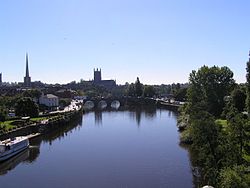 Worcester City Skyline | |
| Location | |
| Grid reference: | SO849548 |
| Location: | 52°11’28"N, 2°13’20"W |
| Data | |
| Postcode: | WR1-5 |
| Dialling code: | 01905 |
| Local Government | |
| Council: | Worcester |
Worcester is a city in and the county town of Worcestershire, standing majestically on the River Severn, over looked by Worcester Cathedral, which remains the dominating presence in Worcester notwithstanding the great town built all around it; the seat of the Diocese of Worcester, one of the oldest bishoprics in the Church of England and in the Early Middle Ages, the richest.
Worcester stands in the midst of Worcestershire in the broad Severn Valley, some 30 miles southwest of Birmingham and 29 miles north of Gloucester.
History
Occupation of the site of Worcester can be dated back to Neolithic times, a village surrounded by defensive ramparts having been founded on the eastern bank of the River Severn in around 400 BC. The position, which commanded a ford on the river, was used in the first century by the Romans to establish what may at first have been a fort on the military route from Glevum (Gloucester) to Viroconium Cornoviorum (Wroxeter) but which soon developed, as the frontier of the empire was pushed westwards, into an industrial town with its own pottery kilns and iron-smelting plants. Roman Worcester might have been the Vertis mentioned in the seventh century Ravenna Cosmography. It was in any event a thriving trading and manufacturing centre for some three hundred years, though by the time of the Roman withdrawal from Britain in 407 it had dwindled considerably in size.
Worcester is not recorded again until the mid-seventh century when documents mention the Anglo-Saxon town of Weorgoran ceaster ("city of the people by the winding river"). Worcester was chosen at this time to be the seat of a bishopric, which it remains. During the later Anglo-Saxon period it was common for the Archbishop of York to serve also as Bishop of Worcester, because the estates belonging to York were greatly diminished since the Norse invasions while Worcester was richer by far, providing the Archbishop with sufficient money to keep him appropriately for his station.
The town was almost destroyed in 1041 after a rebellion against the punitive taxation of Harthacanute. The town was attacked several times (in 1139, 1150 and 1151) during "The Anarchy", the civil war between King Stephen and Empress Matilda, daughter of Henry I.
By late mediæval times the population had grown to around 10,000 as the manufacture of cloth started to become a large local industry. The town was given it autonomy from local government.
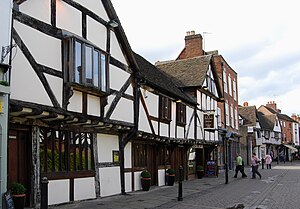
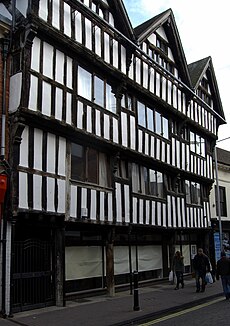
On 3 September 1651 battle was joined at Worcester: the Battle of Worcester was the last fight of the English Civil War: King Charles I had been beheaded two years before but his son, crowned Charles II in Scotland, returned to the fight until defeated in the fields a little to the west and south of the city, near the village of Powick. After battle, Charles returned to his headquarters in what is now known as King Charles house in the Cornmarket, before fleeing in disguise to Boscobel House in Shropshire whence he eventually escaped to France. Worcester was one of the cities loyal to the King in that war, for which it was given the epithet "Fidelis Civitas" ("The Faithful City"). This motto has been incorporated into the arms.
In 1670, the River Severn broke its banks and the subsequent flood was the worst ever seen by Worcester. A brass plate can be found on a wall on the path to the cathedral by the path along the river showing how high this flood went, and other flood heights of more recent times are also shown in stone bricks. The closest flood height to what is known as The Flood of 1670 was when the Severn flooded in the torrential rains of July 2007.
The Royal Worcester Porcelain Company factory was founded by Dr John Wall in 1751, although it no longer produces goods. A handful of decorators are still employed at the factory and the Museum is still open.
During the late eighteenth and early nineteenth centuries, Worcester was a major centre for glove making, employing nearly half the glovers in England at its peak (over 30,000 people).[1] In 1815 the Worcester and Birmingham Canal opened, allowing Worcester goods to be transported to the swelling towns of Birmingham and the Black Country.
The British Medical Association was founded in the Board Room of the old Worcester Royal Infirmary building in Castle Street in 1832. While most of the Royal Infirmary has now been demolished to make way for the University of Worcester's new city campus, the original Georgian building has been preserved. There are plans to reopen the building as a medical museum.
During Second World War, the city was chosen to be the seat of an evacuated government in case of mass German invasion. The War Cabinet, along with Winston Churchill and some 16.000 state workers, would have moved to Hindlip Hall (now part of the complex forming the Headquarters of West Mercia Police), 3 miles north of Worcester, and the two Houses of Parliament would have been seated in Stratford-upon-Avon.
In the 1950s and 1960s, large areas of the mediæval centre of Worcester were demolished and rebuilt as a result of decisions by town planners. There is still a significant area of mediæval Worcester remaining, but it is a small fraction of what was there before the redevelopments.
Economy
Industry is now quite varied. In the nineteenth and early twentieth century, Worcester was a major centre for glove manufacture, but this has declined greatly. The late-Victorian period saw the growth of ironfounders, like Heenan & Froude, Hardy & Padmore and McKenzie & Holland.
Manufacturing
The inter-war years saw the rapid growth of engineering, producing machine tools James Archdale, HW Ward, castings for the motor industry Worcester Windshields and Casements, mining machinery Mining Engineering Company (MECO) which later became part of Joy Mining Machinery and open-top cans Williamsons, though G H Williamson and Sons had become part of the Metal Box Co in 1930. Later the company became Carnaud Metal Box plc.
Worcester Porcelain operated in Worcester until 2008 when the factory was closed down due to the recession. However, the site of Worcester Porcelain still houses the Worcester Porcelain Museum which is open daily to visitors.
One of the most famous things to come out of Worcester is Lea & Perrins Worcestershire sauce, which is made and bottled in the Midland Road factory in Worcester, which has been the home of Lea & Perrins since 16 October 1897. Mr Lea and Mr Perrins originally met in a chemist's shop on the site of what is now the Debenhams store in the Crowngate Shopping Centre.
The surprising foundry heritage of the city is represented by Morganite Crucible at Norton which produces graphitic shaped items and cements for use in the modern industry.
Worcester is the home of what is claimed to be the oldest newspaper in the world, Berrow's Worcester Journal, which traces its descent from a news-sheet that started publication in 1690. The city is also a major retail centre with several covered shopping centres that has most major chains represented as well as a host of independent shops and restaurants, particularly in Friar Street and New Street.
Retail trade
Worcester’s main shopping centre is the High Street, home to the stores of major retail chains. Part of the High Street was modernised in 2005 amid much controversy, many comments were reported in the Worcester News. Many of the issues focussing on the felling of long-standing trees, the duration of the works (caused by the weather and an archaeological find) and the removal of flagstones outside the city’s eighteenth century Guildhall. The other main thoroughfares are The Shambles and Broad Street, while The Cross (and its immediate surrounding area) is the city’s financial centre and location of the majority of Worcester’s main bank branches.
There are three main covered shopping centres in the City Centre, the CrownGate Shopping Centre, Cathedral Plaza and Reindeer Court. There are three retail parks, the Elgar and Blackpole Retail Parks, which are located in the Blackpole area of the city, and the Shrub Hill Retail Park which is located immediately outside the city centre.
Worcester Cathedral
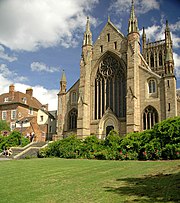
The Cathedral Church of Christ and the Blessed Mary the Virgin, of Worcester, known more usually as Worcester Cathedral, is the most famous edifice in the city. A grand, imposing building, the current cathedral was begun in 1084 while its crypt dates back to the tenth century.
The Cathedral stands in Worcester city centre, on the riverbank overlooking the River Severn. It is the seat of the Bishop of Worcester. Built between 1084 and 1504, Worcester Cathedral represents every style of English architecture from Norman to Perpendicular Gothic. It is famous for its Norman crypt and unique chapter house, its unusual Transitional Gothic bays, its fine woodwork and its "exquisite" central tower which is of particularly fine proportion.[2]
History
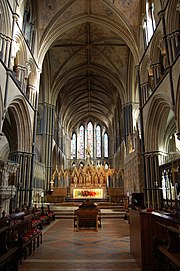
The Cathedral was founded in 680 with Bishop Bosel as its head. The first cathedral was built in this period but nothing now remains of it. The existing crypt of the cathedral dates from the 10th century and the time of St Oswald, Bishop of Worcester. Monks and nuns had been present at the Cathedral since the seventh century, to which Bede attests. The monastery became Benedictine in the second half of the tenth century. The Benedictine monks were driven out at 18 January 1540 and replaced by secular canons.
The former monastic library of Worcester contained a considerable number of manuscripts which are, among other libraries, now scattered amongst Cambridge, the British Library, the Bodleian Library, Oxford, and the Cathedral library at Worcester of today.[3] After the Dissolution of the Monasteries, the building was re-established as a cathedral of secular clergy. It was subject to major restoration work by Sir George Gilbert Scott and A E Perkins in the 1860s.
The chancel contains the tomb of King John; before his death in Newark in 1216, John had requested to be buried at Worcester, and the king was duly buried between the shrines of St Wulstan and St Oswald (both destroyed at the Reformation). Arthur, Prince of Wales is buried here too in a chantry chapel which yet remains; it is thought that the chapel was spared the destruction meted out to other chantries under Henry VIII because it held his elder brother's tomb.
Other famous burials include a Prime Minister, Stanley Baldwin (1867–1947), and the 2nd Duke of Hamilton (1616-1651), Scottish Royalist commander during the Wars of the Three Kingdoms.
Chapter House
The cathedral has the only circular chapter house in the country
Sights and spaces of the city
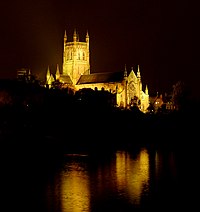
Limited parts of the city wall still remain around the city centre.
There are three main parks in Worcester, Cripplegate Park, Gheluvelt Park and Fort Royal Park, the latter being on one of the battles sites of the English Civil War. In addition, there is a large open area known as Pitchcroft to the North of the city centre on the east bank of the River Severn, which, apart from those days when it is being used for horse racing, is a public space.
Gheluvelt Park was opened as a memorial to commemorate the Worcestershire Regiment's 2nd Battalion after their part in the Battle of Gheluvelt, during First World War.
There are also two large woodlands in the city, Perry Wood, at 30 acres, and Nunnery Wood, covering 52 acres. Perry Wood is often said to be the place where according to local legend Oliver Cromwell met and made a pact with the devil.[4] Nunnery Wood is an integral part of the adjacent and popular Worcester Woods Country Park, itself next door to County Hall on the east side of the city.
Sport
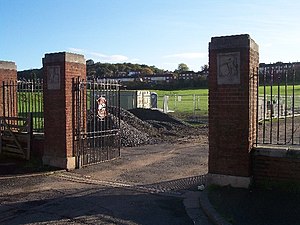
- Cricket: Worcestershire County Cricket Club
- Rugby Union: Worcester Rugby Football Club ("Worcester Warriors")
- Football: Worcester City FC
- Horseracing: Worcester Racecourse is on an open area known as "Pitchcroft" on the east bank of the River Severn.
- Rowing:
- Worcester Rowing Club
- University of Worcester Rowing Club
- University of Birmingham Rowing Club
- Others: Worcester Athletics Club, Worcester St Johns Cycling Club, Worcester Wolves (basketball)
Worcester has a King George V Playing Field in memorial to King George V.
Culture
Festivals and shows
Three Choirs Festival is hosted in Worcester every three years Worcester. The festival dates from the eighteenth century and is credited with being the oldest music festival in Europe. The location of the festival rotates each year between the Cathedral Cities of "The Three Counties"; Gloucester, Hereford and Worcester. Worcester is famous for its championing of English music, especially that of Edward Elgar (a Worcesteshire man), Ralph Vaughan Williams and Gustav Holst. Worcester last hosted the festival in August 2011.
The Worcester Festival is a relatively new venture established in 2003. Held in late August, the festival consists of a variety of music, theatre, cinema and workshops, as well as the already established Beer Festival, which runs as an event within the Worcester Festival. Worcester Festival ends with a spectacular firework display on the banks of the River Severn on the Monday of the August bank holiday.
Worcester Music Festival' is held over a weekend. The festival comprises a weekend original music by predominantly local bands and musicians. All performances are free, and take place throughout the city centre in bars, clubs, community buildings, churches and the library.
The Christmas Fayre is Victorian-themed and a major source of tourism every December.
The Worcester Beer and Cider Festival is held by the Campaign for Real Ale; now the Worcester Beer, Cider and Perry festival: the largest beer festival in Worcestershire and surrounding shires.
Media
- Newspapers:
- Worcester News
- Worcester Standard
- Berrow's Worcester Journal: the oldest newspaper in the world
- Radio:
- BBC Hereford & Worcester
- Wyvern FM
- Youthcomm Radio
References
- ↑ "Worcester glove-making". BBC. http://www.bbc.co.uk/ahistoryoftheworld/objects/ftRyrzGHSdqjcFiBLdgwGA. Retrieved 18 January 2011.
- ↑ Tim Tatton-Brown and John Crook, ‘’The English Cathedral’’
- ↑ N. R. Ker (Ed.) (1964). Medieval Libraries of Great Britain. Royal Historical Society. pp. 205–215.
- ↑ Fraser, Antonia (1973). Cromwell Our Chief of Men. p. 387. ISBN 0-09-942756-7.
Outside links
| Cities in the United Kingdom |
|---|
|
Aberdeen • Armagh • Bangor (Caernarfonshire) • Bangor (County Down) • Bath • Belfast • Birmingham • Bradford • Brighton and Hove • Bristol • Cambridge • Canterbury • Cardiff • Carlisle • Chelmsford • Chester • Chichester • Colchester • Coventry • Derby • Doncaster • Dundee • Dunfermline • Durham • Ely • Edinburgh • Exeter • Glasgow • Gloucester • Hereford • Inverness • Kingston upon Hull • Lancaster • Leeds • Leicester • Lichfield • Lincoln • Lisburn • Liverpool • City of London • Londonderry • Manchester • Milton Keynes • Newcastle upon Tyne • Newport • Newry • Norwich • Nottingham • Oxford • Perth • Peterborough • Plymouth • Portsmouth • Preston • Ripon • Rochester • Salford • Salisbury • Sheffield • Southampton • St Albans • St Asaph • St David's • Southend-on-Sea • Stirling • Stoke-on-Trent • Sunderland • Swansea • Truro • Wakefield • Wells • Westminster • Winchester • Wolverhampton • Worcester • Wrexham • York |